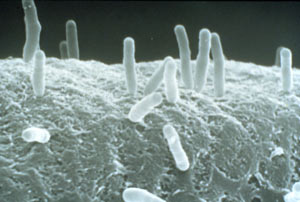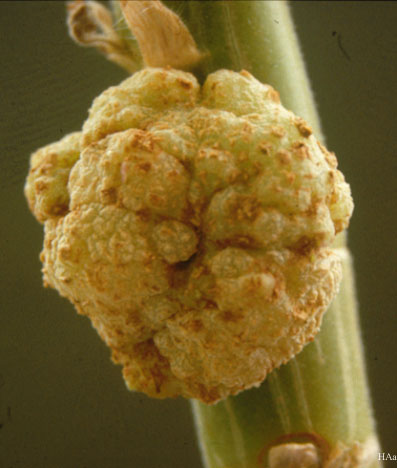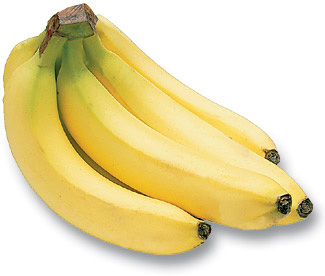Agrobacterium: Difference between revisions
No edit summary |
No edit summary |
||
| Line 1: | Line 1: | ||
''Agrobacterium'' ''tumefaciens'' cells attached to a plant cell. From [http://www.genomenewsnetwork.org/articles/12_01/A_tumefaciens_genome.shtml Genome News Network and Martha Hawes]. | [[Image:Agro1.JPG|frame|''Agrobacterium'' ''tumefaciens'' cells attached to a plant cell. From [http://www.genomenewsnetwork.org/articles/12_01/A_tumefaciens_genome.shtml Genome News Network and Martha Hawes].]] | ||
<br> | |||
<br style="clear:both" /> | |||
{| width="800" cellspacing="2" cellpadding="2" align="center" | {| width="800" cellspacing="2" cellpadding="2" align="center" | ||
| width="802" height="874" bgcolor="#ffffff" valign="top" | | | width="802" height="874" bgcolor="#ffffff" valign="top" | | ||
< | <h2>'''Classification'''</h2><br /><h3>'''Higher order taxa:'''</h3> Bacteria; Proteobacteria; Alphaproteobacteria; Rhizobiales; Rhizobiaceae; Rhizobium/Agrobacterium group <br /><h3>'''Species: '''</h3>''Agrobacterium agile, Agrobacterium albertimagni, Agrobacterium aurantiacum, Agrobacterium larrymoorei, Agrobacterium radiobacter, Agrobacterium rhizogenes, Agrobacterium rubi, Agrobacterium tumefaciens, Agrobacterium vitis, Agrobacterium ''sp. | ||
<font size="+1">'''Description and Significance<br />'''</font>At the turn of the century ''Agrobacterium tumefaciens'' was identified as the causal agent in crown gall disease in dicotyledonous plants. Since then, thorough research has been done on this bacterium's mechanism of tumor induction; in addition, ''Argorbacterium'' is used in numerous research projects as a means with which to introduce new genes into the genomes of a number of plants. | <font size="+1">'''Description and Significance<br />'''</font>At the turn of the century ''Agrobacterium tumefaciens'' was identified as the causal agent in crown gall disease in dicotyledonous plants. Since then, thorough research has been done on this bacterium's mechanism of tumor induction; in addition, ''Argorbacterium'' is used in numerous research projects as a means with which to introduce new genes into the genomes of a number of plants. | ||
Revision as of 13:06, 30 May 2006

ClassificationHigher order taxa:Bacteria; Proteobacteria; Alphaproteobacteria; Rhizobiales; Rhizobiaceae; Rhizobium/Agrobacterium groupSpecies:Agrobacterium agile, Agrobacterium albertimagni, Agrobacterium aurantiacum, Agrobacterium larrymoorei, Agrobacterium radiobacter, Agrobacterium rhizogenes, Agrobacterium rubi, Agrobacterium tumefaciens, Agrobacterium vitis, Agrobacterium sp.Description and Significance Genome Structure Cell Structure and Metabolism
Banana Vaccines
This has already been shown to work using potatoes and a modified E. coli protein that is known to cause severe diarrhea. When mice ate the raw engineered potatoes, they developed the antibodies to the E. coli toxin. Clinical tests on humans eating genetically engineered potatoes also showed that they started producing antibodies against Norwalk virus, which causes acute bouts of diarrhea (Redig 2003). For now, all clinical trials involve genetically modified potatoes or tomatoes, both of which can easily be freeze-dried, transported, and reconstituted. These can be more easily dosage regulated and quality controlled, unlike a banana tree growing in the middle of a village, for example. But the ideal of fresh banana vaccines is still being developed and perfected. References Updated July 28, 2005 Brown, Kathryn. 1996. "Vaccine Cuisine." Environmental Health Perspectives, vol. 104, no. 3. Abraham Loyter, Joseph Rosenbluh, Nehama Zakai, Jianxiong Li, Stanislav V. Kozlovsky, Tzvi Tzfira and Vitaly Citovsky. The Plant VirE2 Interacting Protein 1. A Molecular Link between the Agrobacterium T-Complex and the Host Cell Chromatin?Plant Physiology, July 2005, Vol. 138, pp. 1318-1321. White, Graham. The Molecular Cell Biology Research Group: Research |


